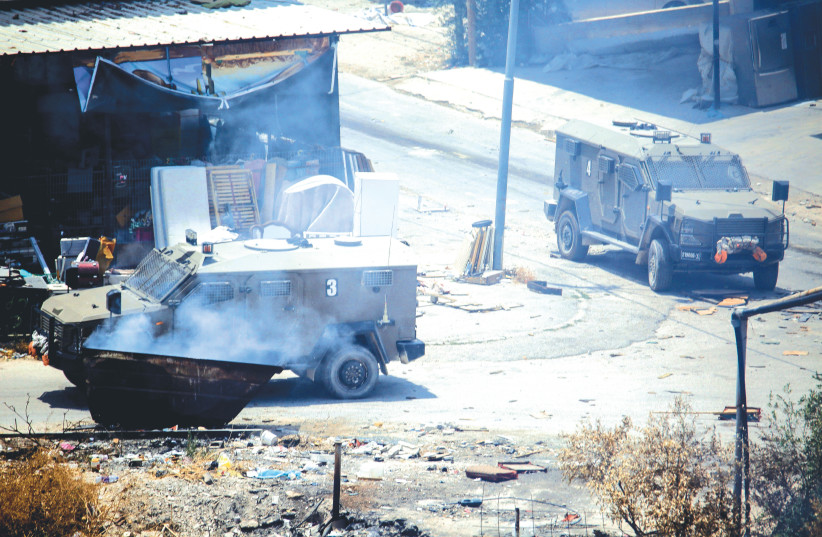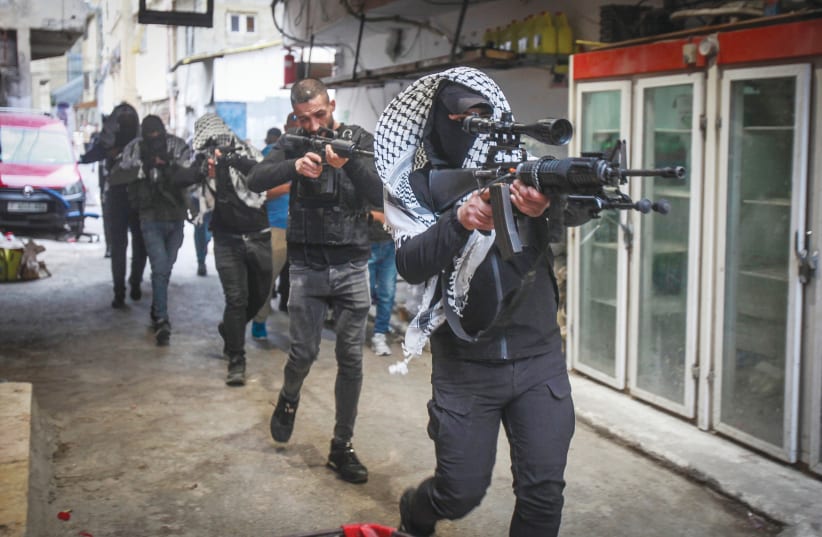In recent months, the Israeli defense establishment has been discussing the multi-arena scenario – a war in which Israel would be assaulted from multiple arenas simultaneously, including Judea and Samaria, with riots erupting throughout Israel.
Iran is spearheading this scenario and working around the clock to develop the capabilities to actualize it. In Judea and Samaria, it appears that the Iranians have been attempting for some time to ignite the area while distancing themselves from these events in order to make it seem that the degradation originated within the territories.
We’ve seen multiple demonstrations of this emerging capacity in the last two weeks. Combat tactics familiar to us from other arenas in the area and worldwide are being used with varying degrees of success in northern Samaria. This has been called the Lebanonization of the West Bank (for example, see Kobi Michael’s excellent piece in Institute for National Security Studies).
Michael correctly describes a “defining narrative event” on June 19 in Jenin when scores of armed Palestinians opened fire on IDF forces who were attempting to apprehend wanted terrorists.
In addition to the gunfire, improvised explosive devices were detonated; one exploded near an IDF armored vehicle, injuring five soldiers. The IED weighed tens of kilograms and was detonated remotely by a spotter, captured on video by Palestinian operatives. The video was later released, along with music and propaganda subtitles. This act reminded many of Hezbollah’s activities against the IDF in southern Lebanon.

Reminders of the Lebanon security zone
Is this truly a process of Lebanonization? The “Lebanon generation” – those who served there or awoke to news of soldiers killed in the security zone from the 1980s until the unilateral withdrawal in May 2000 – believes the answer to be affirmative.
A “Lebanese outline” is clear in the video of the IDF vehicle encountering an IED in Jenin accompanied by heavy gunfire. These ambushes by Hezbollah and other organizations in Lebanon resulted in a daily blood toll from the IDF and the South Lebanon Army and are engraved in our collective memory.
About a week after the IED incident in Jenin, the IDF Spokesperson’s Office released a statement regarding the failed launch of two rockets from Jenin – this is neither the first nor the last attempt to threaten central Israel with rockets launched from northern Samaria. The distance between Jenin and Israel’s main cities is less than 20 kilometers.
All of this is occurring amid a terror surge that Israel has been unable to stop for the past year and a half. In the background, there is a discussion about the destiny of the PA the day after Mahmoud Abbas, who will soon turn 90.
But the region of Judea and Samaria is not Lebanon.
Judea and Samaria, part of the biblical Land of Israel, are the origin of the Jewish nation. Several hundred thousand Jews who are Israeli citizens currently reside there. Creating a complete separation between them and the Palestinians is nearly impossible.
The threat of rockets being fired from Judea and Samaria toward Israeli cities, the airport, and other infrastructure has prevented successive Israeli prime ministers from unilaterally withdrawing from the area known as the “West Bank,” providing terrorist organizations complete freedom to threaten the heart of the State of Israel.
In Lebanon, such a withdrawal enabled Hezbollah to produce the capacity to launch thousands of rockets per day unimpeded in the event of a conflict.
The past two weeks’ events have sparked a lively discussion among Israeli security officials regarding what action to take. Continue “mowing the lawn” (with relative success) or address the root cause.
What is the scope of the military operation required in Jenin and what armaments should be used in the new type of anti-terrorism campaign we are conducting in Judea and Samaria? This has become the central question in Israeli discourse.
On June 21, for example, an assassination was carried out by means of an unmanned aerial vehicle, in the vicinity of Jenin. This preventative measure was implemented against a group of three militants who conducted shooting attacks against Israeli communities bordering the northern region of Jenin.
But there is, in my opinion, a much larger issue at hand: What is the future of the Palestinian Authority?
It is losing the capacity to control the territory as Fatah operatives participate in battling against the IDF in the Jenin refugee camp. Palestinians have lost confidence in the fraudulent PA, which has not held elections since 2006. Polls indicate that Hamas, which has ruled Gaza since the last elections, enjoys widespread support in Judea and Samaria. Will the IDF be able to replace Palestinian security organizations and sustain security on PA territory in the long run?
Despite divergent opinions in Israel, the fundamental premise is unmistakable: Lebanonization is not merely a fighting style; it is primarily a manifestation of the Iranian vision of multiple arenas with organized militia-level combat capabilities. Therefore, the State of Israel must cultivate thought and discourse on fundamental issues that transcend the activities of the security forces in one way or another.
The new threat we confront may position Israel in an entirely different strategic predicament. This is due not only to the number of arenas but also to their location – within the PA and from the PA into Israel. This position, combined with paramilitary capabilities, is novel and hazardous and it cannot be handled the same way we handled the Second Intifada at the turn of the century.
The writer is the founder and president of Alma – Research and Education Center.
